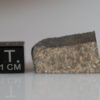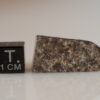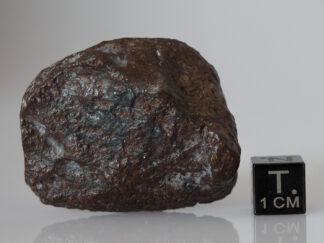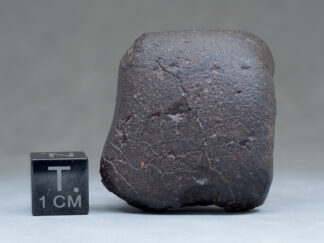Description
8.3g crusted fragment sold with label/certificate.
(source : mindat.org) In 1917 Merrill described in detail 3 meteoritic stones and some fragments (total mass 7.6 kg) which had been found ~8 km SW of Plainview. Merrill was able to provide a moderate inventory of the chondritic mineralogy and an initial description of the thoroughly brecciated textures of what had presumably been a single meteorite breaking up shortly before impact. Despite the strong overlay of its weathering ‘varnish,’ Merrill further noted regions with distinct color variations (darkening). Several additional stones were received shortly after Merrill prepared his report so that a total of 24 kg had been recovered by the end of 1917. During a two day Plainview stopover in 1933 Harvey Nininger recovered an even larger amount of meteoritic matter. Indeed, over a period of 15 years several 100 kg of additional material were recovered in a ~6 x 26 km strewn field due to his efforts.
As noted by Merrill, the meteorite is dominated by the distinct chondrules (olivine and/or pyroxene-rich), chondrule fragments, matrix, and aggregates of (often weathered) Fe-Ni metal and troilite. Orthopyroxene, clinopyroxene and albitic plagioclase are all present. Using more precise contemporary data, the olivine (Fa~18-19) and low Ca-clinopyroxene (Fs~17) place Plainview (1917) well within the H-chondrite geochemical group. Signs of shock have been explored in detail. Weathering products (goethite, limonite) are also noted by various authors. However, perhaps most significant is that the large mass has allowed a thorough study of minor constituents (Cf., Ramdohr, 1977) as well as some intriguing studies of its exotic clasts.
Plainview (1917)’s cosmic ray exposure (CRE) age of ~6.0 Ma is part of a cluster of 6-10 Ma CRE ages involving more than half of the studied H chondrites with H5 membership especially prominent. Presumably, most of the H5 meteorites which reach the earth during our current epoch were involved in one or two disruptive collisions less than 10 million years ago which then sent numerous small fragments (meteoroids) into eventual collisions with the earth.
The H chondrites (relatively high in total iron) are the second largest group of ordinary chondrites and represent ~40% of the witnessed and fully classified meteorite falls. The H5 petrologic type is the largest H subgroup and accounts for ~50% of the H falls. The Plainview (1917) total mass makes it the 3rd most massive recovered H5 chondrite. Only the 4 ton Jilin, China (1976) and the 1.1 ton Kunya-Urgench, Turkmenistan (1998) H5 falls were more massive.
Specimens of the Plainview (1917) mass have been distributed to a number of institutions worldwide. The largest amount of material is currently held at the Center for Meteorite Studies at Arizona State University (derived from Nininger’s holdings). Over 25 kg are also held by the Natural History Museum in London (also mostly derived from Nininger’s holdings) and by the United States National Museum in Washington, DC.
What’s in a name? For approximately half a century the Plainview (1917) meteorite, an H5 ordinary chondrite, was known simply as the ‘Plainview’ meteorite. However, in 1950 another 2.2 kg and apparently separate chondritic mass was recovered in the same general area so the two masses were labelled ‘Plainview (1917)’ and ‘Plainview (1950),’ respectively. By 2010, three additional chondritic stones had been recovered from nearby, but sometimes somewhat uncertain original sites. In all, 5 separate meteorites are now listed at the Meteoritical Bulletin Database and appear to represent a minimum of at least 3 separate falls. For example, the ‘Plainview (d)’ meteorite, an L6 chondrite, is clearly a separate fall. The evidence for separate events for the small ‘Plainview (c)’ and ‘Plainview (e)’ stones, however, does not appear to be decisive at this time.







